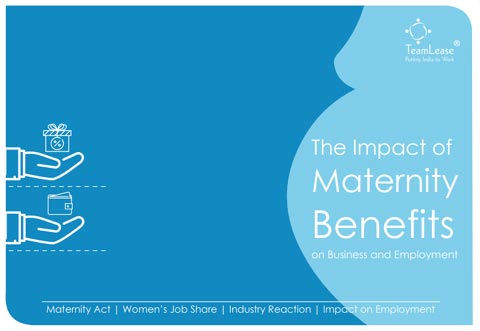No. of views : (3825)
TeamLease latest report - The Impact of Maternity Benefits on business and Employment
Posted on: 27/Jun/2018 5:56:46 PM

TeamLease Services, India�s largest composite staffing company, today released its latest report- The Impact of Maternity Benefits on Business and Employment, a detailed analysis on the maternity amendment bill and its effect on women workforce participation. According to the report, though one of the most progressive amendments, India Inc seems to be divided in its opinion on how the Maternity (Amendment) Bill 2017 will impact the acceptance and participation of women workforce. As per the report, the immediate term positive impact of the amendment may be restricted to only 3 out of the 10 sectors covered under the study. However, in the long term companies across the sectors will realize the benefits of the amendment.
An in-depth study on the consequences, as per the report, the immediate repercussion is not in favour of women talent. One of the immediate effects would be loss of jobs. The bill will cause an estimatedjob loss of 11 lacs to 18 lacs in FY18-19 across the 10 sectors considered for the study . Further, while currently, only 27% of total workforce in India is women and 14% of the overall women workforce is employed in the formal sector, bill will significantly hamper the entry of new women into the workforce. Apart from impacting the hiring intent, many of the respondents opined, that the bill will also affect the behaviour of industry at large. In some sections of the industry,the behavior is likely to be legitimate and visionary, where they would support the intent of bill.In other section the behavior is likely to be less encouraging. However, on the brighter side it will have a positive effect on retention. According to the Employers who were surveyed for this study the post-maternity attrition which is currently as high as 56% will drop to 33% in the next 4 years due to the adoption of the Maternity (Amendment) Bill 2017.
From an organization perspective, large companies (both private & public sector) as well as medium sized public-sector companies seems to be more enthusiastic about the amendment. They are likely to even hire more women as the financial and opportunity cost of replacement is higher than the cost of retention. Small sized public sector companies are positive but may not increase the intake of women than what they hired previously.
But, Start-ups, SME�s, medium-sized multinational companies, sectors with legacy HR practices and closely-held family run businesses across sectors perceive the amendment as a deterrent and likely to reduce intake of women. Their apprehension is due to the overhead expense of maternity leave reimbursement andcost of establishing post-maternity support infrastructure. As per this study some sections of SME�s which includes manufacturing and services businesses may resort to unethical practices such as decreasing the salary upfront at the point of hiring as well reduce intake of women. Further, for start-ups and SMEs complying with the bill is a challenge as they depend on investor funding and survive on razor thin margins. Also, the probability that employees availing of the benefit may not re-join the same company is also major concern leading employers to consider the amendment as hurdle.
The benefits of the bill are likely to be realized in the short term [up to 1 year] by new-age businesses but the sectors that employ women in large numbers s and have continuous, dynamic, operations are likely to be adversely affected in the short term. The medium term [1 � 4 years] impact is likely to be positive for all sectors except those with a legacy of male-domination in the workplace.
Key Findings of the Survey
Women�s share in the Indian workforce is at 27%, as of 2017
- Raising the female Workforce Participation Rate can potentially result in the share of women in jobs going up to 35%, and increase GDP growth by 16% to 60%, by 2025.
- The amendment would have a �high� to �medium� positive impact in 20 of the 30 states in India.
- India could potentially add 6.8 crore women to its workforce by raising the rate of female workforce participation
- Women with higher educational qualifications are seen to occupy professional roles in about 12% to 60% more cases than men.
Women�s role in the workplace is marked by poor statistics across the board.
- Share of population: 48.5% [61.6 crore of 127 crore]
- Share of Workforce: 27% [13.8 crore out of 51.1 crore]
- Share of Formal Employment: 14% [56.6 lacs out of 4 crore]
- Share of Informal Employment: 28% [13.2 crore of 33.8 crore]
- 95.9% of working women are employed in the informal sector [13.2 crore out of 13.8 crore]
There is likely to be fewer takers for women in the workplace in the short term [up to 1 year].
- The net effects of the amendment are likely to be negative, with a potential job loss of about 1.6% to 2.6% across sectors, during FY 2018-19
- The job loss due to the enforcement of the act is likely to be between 11 lac and 18 lac during FY 2018-19.
Demand for women in the workforcewill improve, over the medium term [1 � 4 years], provided those businesses that are enthusiastic build success stories for others to emulate
- Large, professionally managed companies (both private & public sector) and medium sized public sector companies will actively back the amendment and are likely to hire more women
- Medium-sized multinational companies will have the most varied response � from being advocates of diversity to reducing demand for female talent
- Large and medium sized private companies [especially closely held / family owned] are likely to either maintain status-quo or reduce demand for female talent
- Start-ups are likely to reduce demand for female talent
- SME behaviour [across services and manufacturing] is typically likely to vary from reduced demand for women to unethical behaviour of reducing the upfront salary for women
Commenting on the report, Ms. Rituparna Chakraborty, Co-founder & EVP, TeamLease Services, said, �The Maternity Benefit (Amendment) Act 2017 positions India as the third most progressive country after Canada and Norway. However, the bill in spite of having intent to benefit the women workforce has been counterproductive to the new women workforce participation in the next 1-4 years. But the investment employers will make towards this end will go a long way in improving women�s workforce participation and, thereby, boost national income. As with most reforms of such scale, the mechanics of change a are as critical as the reform itself. It would require a participative approach. The government should support the corporate at every step by allowing flexibility as well as financial support so that all types of companies can be a part of the endeavor without hesitation.�
Apart from corporate the report also analyses the impact of the bill of the States. The probable �Impact of Maternity Benefits� was computed as a weighted average of workforce participation rate and gender parity, for each state. Andhra Pradesh, Chhattisgarh, Meghalaya, Mizoram, Nagaland, Kerala, Sikkim, Tamil Nadu and Telangana were found to be �High-Positive� states with the value of �Impact� found to be greater than or equal to 20%. While states like Maharashtra, Uttar Pradesh, Bihar, Assam, Odisha, Punjab have a �Medium-Negative� impact with the value of �Impact� found to be less than 10%.
The Impact of Maternity Benefits on Business and Employmentis a comprehensive analysisthat brings forth the impact of maternity act on women�s job share. The analysis covers around 10 key sectors comprising of aviation, BPO / ITes, Real-estate, e-commerce, education, BFSI, IT, Manufacturing, retail and tourism. A comprehensive analysis it looks at the long term as well as short term consequences of the amendment on the talent as well as employers.
Post your requirement - We will connect with the right vendor or service provider








